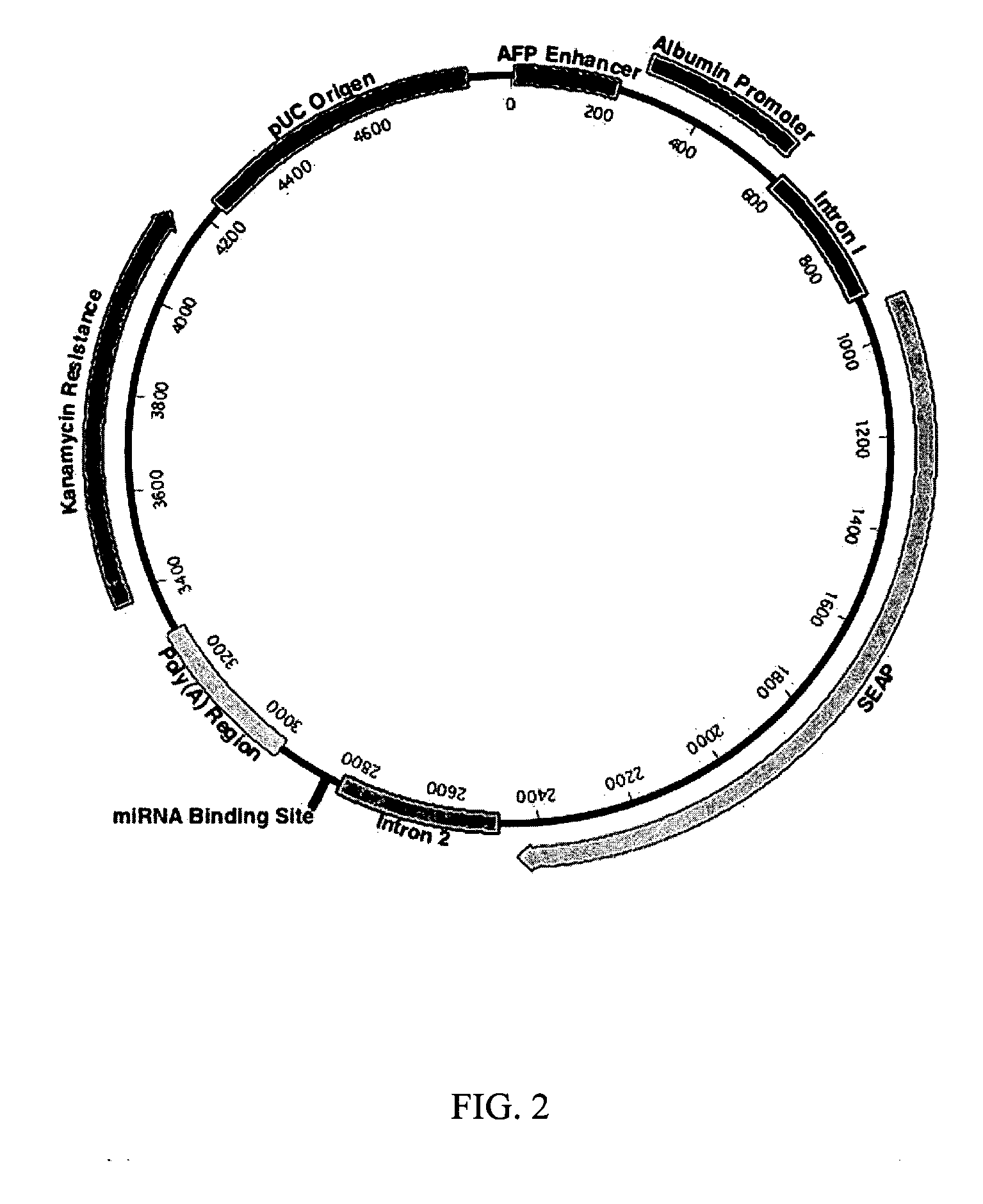Monitoring microrna expression and function
- Summary
- Abstract
- Description
- Claims
- Application Information
AI Technical Summary
Benefits of technology
Problems solved by technology
Method used
Image
Examples
example 1
Plasmid Constructs
[0056] A. Short term miRNA sensor plasmids. Short term miRNA sensor plasmids were created by cloning miRNA binding sites into the 3′ UTR of the Renilla luciferase gene in the PSICHECK™-2 Vector (Promega, Madison, Wis., GenBank accession #AY535007, FIG. 1). This vector contains the Renilla luciferase and firefly luciferase genes under the control of separate enhancer / promoters. The firefly luciferase (Photinus pyralis) gene serves as an internal control which permits normalization of delivery efficiency.
[0057] A subset of 40 known miRNAs was chosen and their exact complements and respective antisense sequences were synthesized (IDT, Coralville, Iowa). Sequences of mature mouse miRNAs were acquired from the miRBase Sequence Database (Wellcome Trust Sanger Institute, United Kingdom). Equal molar amounts of each oligonucleotide pair were annealed and ligated into the PSICHECK™-2 plasmid. A subset of these, for microRNAs miR-122, miR-18, miR-192, miR-143 and miR-1,. a...
example 2
Plasmid Delivery and Reporter Protein Assays
[0065] A. Mouse hydrodynamic tail vein injections and dual luciferase assay. Approximately 20 g ICR mice (Harlan-Sprague Dawley) were injected in the tail vein with 10 μg of plasmid DNA with or without 10 μg of miRNA inhibitory antisense oligonucleotide in 2 ml Ringer's solution (1 ml per 10 grams body weight) in 5-7seconds according to the hydrodynamic delivery method (U.S. Pat. No. 6,627,616) for delivery to hepatocytes. The liver was harvested and homogenized one day after injection. The homogenate was assayed for Renilla luciferase and firefly luciferase activity using the Dual Luciferase Assay (Promega Corp. Madison, Wis.) and the ratio of Renilla luciferase to firefly luciferase calculated. Data was normalized to animals receiving the PSICHECK™-2 vector without miRNA binding sites, parent vector pMIR393.
[0066] B. Mouse hydrodynamic limb vein injections and dual luciferase assay. ICR mice were injected in the saphenous vein with 20 ...
example 3
Short Term miRNA Sensor Plasmids Effectively Monitor miRNA Activity in Mouse Liver
[0068] Short term miRNA sensor plasmids pMIR393, pMIR394, pMIR395, pMIR398, pMIR399, and pMIR400 (see Table 2) were delivered to hepatocytes in vivo as described above. Renilla luciferase expression in the liver from the miRNA sensor plasmids is shown in FIG. 4. According to published data, miR-122a and miR-192 are highly expressed in liver and but have not been detected in skeletal muscle. The presence of the miR-122a and miRNA192 binding sites resulted in nearly complete inhibition of expression of the reporter gene. The presence of the miR-1 binding site did not result in inhibition of reporter gene expression. The presence of the miR-143 and miR-1 8 binding sites resulted in 74.2% and 56% inhibition of reporter gene expression, respectively.
PUM
| Property | Measurement | Unit |
|---|---|---|
| Fraction | aaaaa | aaaaa |
| Fraction | aaaaa | aaaaa |
| Alkalinity | aaaaa | aaaaa |
Abstract
Description
Claims
Application Information
 Login to View More
Login to View More - R&D
- Intellectual Property
- Life Sciences
- Materials
- Tech Scout
- Unparalleled Data Quality
- Higher Quality Content
- 60% Fewer Hallucinations
Browse by: Latest US Patents, China's latest patents, Technical Efficacy Thesaurus, Application Domain, Technology Topic, Popular Technical Reports.
© 2025 PatSnap. All rights reserved.Legal|Privacy policy|Modern Slavery Act Transparency Statement|Sitemap|About US| Contact US: help@patsnap.com



